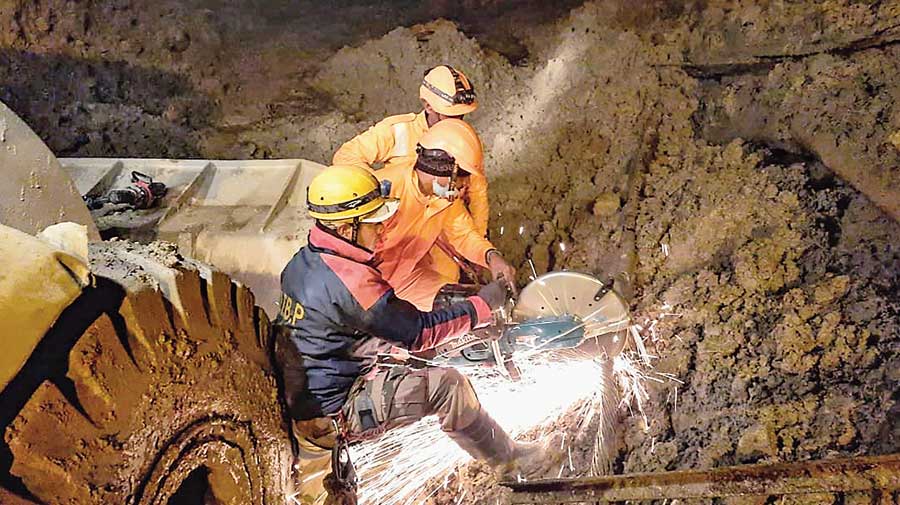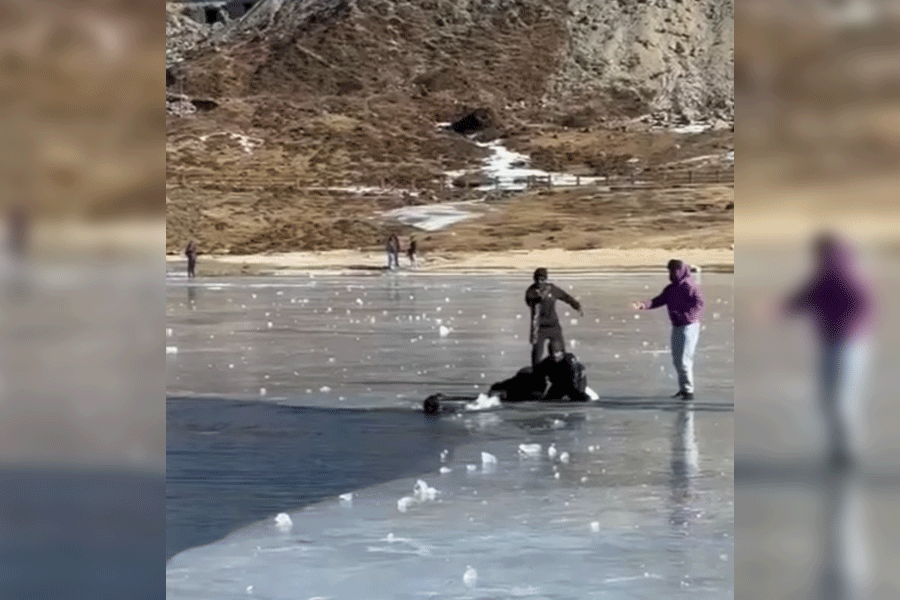Efforts to rescue 25 to 35 people trapped in a blocked mountain tunnel in Uttarakhand since Sunday morning’s flash flood have stalled because of flow-back by a “sludge” of rocks, slush and water that has hobbled the rescuers and poses a danger to them.
Teams from the army, Indo-Tibetan Border Police (ITBP) and the state and national disaster response forces had by Tuesday evening cleared about 100 metres of the 180-metre tunnel but couldn’t advance thereafter.
“Debris and water are flowing back while we are cleaning the tunnel. We need to be careful because the water and debris might flow back with enormous force when we try to move forward,” ITBP deputy inspector-general Aparna Kumar said.
Thirty-four bodies — of labourers working on two hydropower projects and villagers from nearby areas in Chamoli district — had been recovered by Wednesday evening but 170 people were still missing, state authorities said.

Personnel of ITBP and other agencies cut the loose ends of pipes and wires inside the tunnel. PTI
“There’s been hardly any progress in the rescue operation. We have recovered 34 bodies but have no confirmed details about the dead and the missing,” state director-general of police Ashok Kumar said.
The number of the missing has been given out on the basis of the names provided to the government by the companies involved in the two power projects. A senior employee of one of these companies had said off the record that the company did not have full records of all the labourers because it hired them through small-time contractors.
The Rishiganga hydropower project near Raini village has been completely destroyed while the NTPC’s project near Tapovan village is heavily damaged.
It’s a group of Tapovan workers, managers and engineers who remain trapped in one of the project tunnels. Two other tunnels — one of each project — had been cleared earlier, with 27 workers rescued.
Glacier theory back
The theory that the flash flood was caused by a “glacial outburst” — offered on Sunday and dismissed on Monday in favour of an avalanche theory — received a shot in the arm on Wednesday, with the additional claim of an earthquake as the possible trigger.
Chief minister Trivendra Singh Rawat had on Sunday cited state scientists to suggest a glacier on the Nanda Devi mountain had broken apart and caused the devastation. Scientists elsewhere too said a glacial lake breaching its banks was the possible cause.
On Monday, however, Rawat quoted the Indian Institute of Remote Sensing, Dehradun — an arm of the Indian Space Research Organisation — to say satellite imagery suggested that recent snowfall on the mountains, loosened by a landslide, had come down in the form of an avalanche. He said there was no glacier on the Nanda Devi.
However, the weather office said it had no evidence of heavy snowfall at the site since Thursday, either.
Now a fresh study has suggested that a 500-metre-long “hanging glacier” on the Raunthi peak, 5,600 metres above the sea level, broke and caused the devastation.
“According to an analysis of data collected by Planet Labs, an agency from San Francisco, the glacier was hanging at 82 to 85 degrees. A portion of the glacier and boulders slid and travelled about 11km on February 6 (Saturday) night and fell on the upper Rishiganga catchment area, which is at an altitude of 3,800 metres,” M.P.S. Bisht, director of the Uttarakhand Space Application Centre (USAC), Dehradun, told reporters.
“The ice and debris formed an artificial lake (where the portion of the glacier fell). This lake collapsed the next morning, bringing devastation to the lower Rishiganga catchment area.”
Bisht said an earthquake had occurred in the area at the time the hanging glacier broke and fell. He said there had also been fresh ice from recent snowfall on both sides of Raunthi, which too barrelled down along with the boulders.
According to a USAC study conducted between 2002 and 2018, some 26sqkm of the 243sqkm glaciated area in the Nanda Devi region had vanished in the previous 37 years because of global warming.











